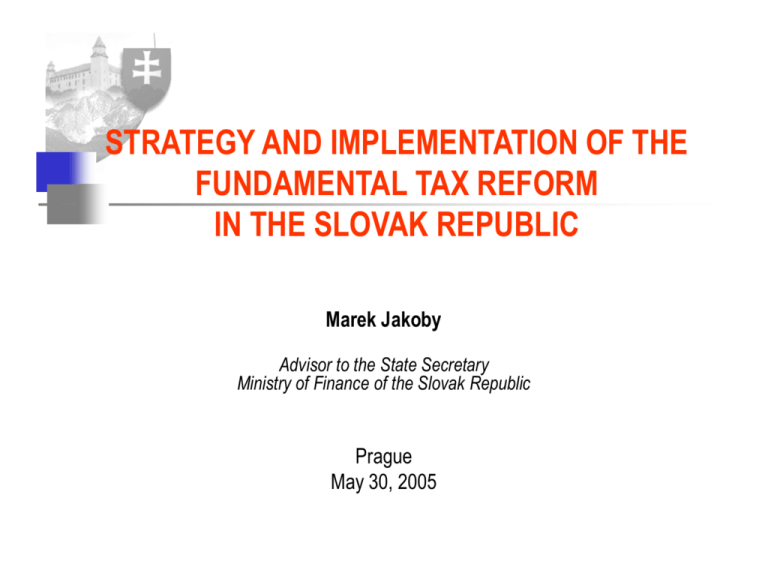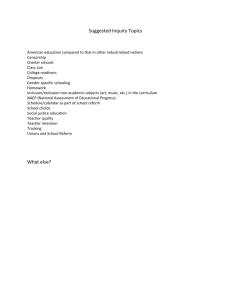Fundamental Tax Reform in the Slovak Republic
advertisement

STRATEGY AND IMPLEMENTATION OF THE FUNDAMENTAL TAX REFORM IN THE SLOVAK REPUBLIC Marek Jakoby Advisor to the State Secretary Ministry of Finance of the Slovak Republic Prague May 30, 2005 FISCAL REFORM: GENERAL CONTEXT MAIN GOVERNMENT’S OBJECTIVE: • reduce the general government deficit under 3.0% of GDP by 2006… • … while simultaneously decreasing public expenditures as a share of GDP Fiscal Position of General Government (% of GDP) 2002 2003 2004 2005 2006 2007 Revenues 38.3 36.0 37.3 37.0 36.6 36.5 Expenditures 44.0 39.6 40.6 40.4 39.5 38.4 Net borrowing* -5.7 -3.6 -3.3 -3.4 -2.9 -1.9 * excl. costs of second pillar of the reformed pension system TAX REFORM IS A PART OF A COMPLEX REFORM PACKAGE WHICH INCLUDES: – 3-year general government budget – program budgeting • Health care reform: – introducing co-payments and specification of basic package of services covered by obligatory health insurance • Pension reform: – reformed PAYG – introduction of second, pre-funded pillar • Social assistance reform: – tightening provision of social benefits • Public administration reform – fiscal decentralization THE SLOVAK TAX REFORM: GOALS BASIC PHILOSOPHY: LIGHT, NONDISTORTIVE, SIMPLE AND TRANSPARENT TAX SYSTEM • create business and investment friendly environment for both individuals and companies • eliminate existing weaknesses and inefficiencies in the tax law • eliminate distortive roles of tax policy as instruments for achieving non-fiscal goals • improve tax fairness by taxing all types and all amounts of income equally FISCAL IMPACT OF THE TAX REFORM • reform designed to be revenue neutral in 2004 • serious attention paid to fiscal impact quantifications • 5 independent estimations made by following institutions: – – – – – International Monetary Fund Slovak Ministry of Finance - Institute of Financial Policy special high-level working committee Infostat (Slovakia) Slovak Academy of Sciences • conservative estimates adopted for fiscal purposes TAX REFORM – main objectives and principles • FLAT INCOME TAX - simplicity, fairness, proportionality – cutting number of tax rates (18 → 1) – broadening tax base (eliminating special treatments and exceptions) • allows low standard tax rate • minimizes distortions in the economy – eliminating double taxation – progressivity of personal income taxation reduced but not eliminated (tax free threshold bound to the living minimum) Tax-free items – Only one but much higher tax-free treshold • Basic tax allowance for tax payer annually automaticaly indexed to minimum subsistance level (as 19,2 x ) (SKK 38,760 → SKK 80,832 →SKK 87 936 (2,800 USD) in 2005) • Spousal allowance (SKK 12,000 → SKK 80,832 →87 936 in 2005 – Introducing annual child tax credit • SKK 4,800 (USD 155) per child (part of new child support and working incentives policy) – Since 2005 introducing purpose-oriented allowance • SKK 12,000 (tax-free long-term savings, ageing issue) FLAT TAX STILL ENSURES PROGRESSIVE TAXATION OF INCOMES Effective Tax Rate 20% 18% 16% 14% 12% 10% 8% 6% 4% 2% 0% 0.0 0.5 Poverty Line 1.0 1.5 2.0 2.5 3.0 3.5 4.0 Personal Income (as a percentage of the average salary in the economy) 4.5 5.0 TAX REFORM – main objectives and principles • Efficiency – growth-oriented – Incentives to work - lowering effective taxation of low- and high-income groups – Support of business environment • Broad revenue neutrality – Primary government objective: fiscal consolidation allowing for euro adoption in 2009 => shifting tax burden from direct toward indirect taxes Direct taxes: Flat personal and corporate tax, abolishment of inheritance, gift and real estate transfer tax, tax on dividends Indirect taxes: unification of VAT rates 14%, 20% → 19%, tobacco, beer and mineral oil tax rates) IMPLEMENTATION STRATEGY Chronology of the changes in the tax laws 1. Changes in indirect taxes: • • amendment of VAT Act – introduction of unified rate of 19% (January 2004; before: 20% and 14%) amendment to the Acts on Excise Duties – increase of certain excise tax rates: mineral oils, beer and tobacco products 2. Changes in direct taxes: • new Income Tax Act – introduction of flat tax (January 2004) • new Real Estate Transfer Tax Act – abolition of gift and inheritance tax and introduction of 3% flat rate for real estate transfer tax (completely abolished as by January 2005) 3. Changes in indirect taxes in compliance with EU tax legislation - new VAT Act and new Excise Duties Acts - as of May 1, 2004 THE REFORM RADICALLY DECREASES ECONOMIC DISTORTIONS CREATED BY THE TAX SYSTEM 2003 PERSONAL INCOME TAX RATE CORPORATE INCOME TAX RATE VALUE ADDED TAXES OLD SYSTEM 5 tax rate bands: 10%, 20%, 28%, 35% and 38% 25% standard rate: 20% lowered rate: 14% 2004 NEW SYSTEM 1 flat rate: 19% 19% one unified rate: 19% THE REFORM RADICALLY SIMPLIFIES THE TAX SYTEM AND INCREASES ITS TRANSPARENCY 2003 2004 PERSONAL INCOME TAX BASE OLD SYSTEM LOTS OF exceptions, exemptions and special regimes NEW SYSTEM NO exceptions, exemptions and special regimes CORPORATE INCOME TAX BASE LOTS OF exceptions, exemptions and special regimes NO exceptions, exemptions and special regimes OTHER TAXES LOTS OF special taxes and rates VIRTUALLY NO special taxes and rates THE REFORM ELIMINATES MOST FORMS OF DOUBLE TAXATION OF INCOME DIVIDEND TAX GIFT TAX INHERITANCE TAX REAL ESTATE TRANSFER TAX (as of 2005) TAX RATES FACED BY INVESTORS IN DIFFERENT COUNTRIES Slovakia Estonia Finland Hungary Czech Republic Poland Germany Japan UK France Ireland USA (New York) 0% 10% 20% 30% 40% 50% Corporate tax rate Effective tax rate on investment income faced by a private investor (combined corporate tax and dividend tax) 60% PRELIMINARY RESULTS OF TAX REFORM • Tax revenue development in 2004 showed that the estimates of the Ministry of Finance have been correct and collected overall tax revenues were in line with the estimates • Simplified administration and lower total tax burden have lead to improved incentives for entrepreneurship and investment • Positive impact on employment is expected in medium term • From macroeconomic and budgetary point of view it is too early to evaluate the overall impact of the tax reform • Reform contributed to higher rating of the Slovak Republic AAA- (S& P); A2 (Moody´s) TAX REVENUES TAX REVENUES (% OF GDP) 2002 2003 19,0 18,2 2004 budget 17,6 -direct tax -indirect tax 6,9 12,1 6,9 11,3 Social security contribution Total Tax Revenues 14,4 33,5 13,9 32,1 Tax * Forecast 2004 2005* 2006* 17,7 17,4 17,3 5,7 11,9 6,3 11,4 5,0 12,4 5,0 12,3 13,4 31,0 13,4 31,1 13,5 30,9 13,5 30,8 CONCLUSION: POLITICAL WILL AND MANAGEMENT ARE KEY FOR SUCCESSFUL REFORMS • must have a clear vision where you want to go • timing is key in the implementation – implement less popular steps first • resist lobbies and entrenched interests – if you give in to one demand, you will be less able to say no to others • compensate the most vulnerable part of the population THANK YOU FOR YOUR ATTENTION Marek Jakoby Advisor to the State Secretary Ministry of Finance of the Slovak Republic Štefanovičova 5 817 82 Bratislava Slovak Republic tel.: +421 2 5958 2305 fax: +421 2 5958 2354 e-mail: mjakoby@mfsr.sk Internet: www.finance.gov.sk



